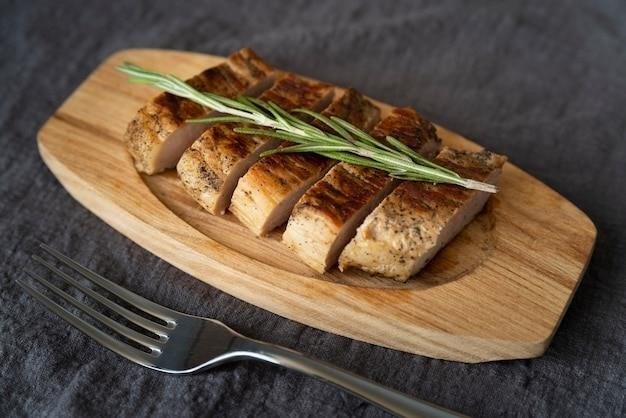Smithfield Pork Tenderloin Crock Pot Cooking⁚ A Comprehensive Guide
This guide provides a complete walkthrough for cooking succulent Smithfield pork tenderloin in a crock pot. Discover optimal cooking times, seasoning techniques, and serving suggestions for a delicious, effortless meal. Learn how to achieve perfectly tender results every time.
Preparing the Smithfield Pork Tenderloin
Begin by carefully removing any excess fat from the Smithfield pork tenderloin. This step helps prevent overly greasy results and ensures even cooking. Pat the tenderloin dry with paper towels; this is crucial for proper browning and searing if you choose to do so before slow cooking. Consider trimming the tenderloin to fit comfortably within your crock pot, cutting it lengthwise if necessary to ensure even heat distribution and faster cooking times. For smaller crock pots, halving the tenderloin might be advisable. If using a pre-seasoned tenderloin, like Smithfield’s Roasted Garlic & Herb variety, you may require less additional seasoning. However, you can still enhance the flavor with a dry rub or marinade for added depth and complexity. Remember, proper preparation significantly contributes to a delicious final product.
Seasoning and Marinating Options
The beauty of crock pot cooking lies in its ability to infuse flavors deeply into the meat. For Smithfield pork tenderloin, a simple seasoning blend can elevate the taste significantly. Consider a classic garlic herb rub, combining minced garlic, dried rosemary, thyme, and a touch of salt and pepper. Alternatively, a more robust seasoning like Smithfield Steakhouse Seasoning adds a savory punch. For a bolder flavor profile, marinate the tenderloin beforehand. A simple balsamic vinaigrette, combining balsamic vinegar, olive oil, garlic, and herbs, works wonders. For a sweeter option, consider a cranberry sauce-based marinade, adding a touch of brown sugar and red wine vinegar for complexity. Remember, the marinade time should be at least 30 minutes, allowing the flavors to penetrate the meat effectively. Experiment with different combinations to find your perfect flavor match. Don’t be afraid to get creative!
Choosing the Right Crock Pot and Settings
Selecting the appropriate crock pot is crucial for achieving tender, flavorful results. A 2-4 quart crock pot is ideal for a standard-sized Smithfield pork tenderloin, ensuring even cooking. Larger crock pots might lead to uneven cooking, while smaller ones could be too cramped. Before placing the tenderloin inside, ensure the crock pot is clean and free from any lingering odors. For cooking settings, “low” is generally recommended for pork tenderloin, minimizing the risk of overcooking and drying out the meat. Cooking on low for 6-8 hours typically yields optimal tenderness. However, cooking times can vary depending on the size of the tenderloin and your crock pot’s performance. Always use a meat thermometer to ensure the internal temperature reaches 145°F (63°C) before serving. This ensures food safety and guarantees a juicy, perfectly cooked Smithfield pork tenderloin. Remember to check your crock pot’s manual for specific instructions and recommendations.

Cooking the Smithfield Pork Tenderloin in the Crock Pot
This section details the process of slow-cooking your seasoned Smithfield pork tenderloin to perfection in your chosen crock pot, ensuring a juicy and flavorful outcome.
Low and Slow Cooking Times
For the most tender and flavorful results when cooking Smithfield pork tenderloin in a crock pot, the “low and slow” method is highly recommended. This approach involves cooking the tenderloin on the low setting for an extended period, allowing the meat to become incredibly tender and absorb the flavors of any marinade or seasoning. The cooking time will vary depending on the size of your tenderloin, but generally, you can expect to cook it on low for 6-8 hours. It’s crucial to monitor the internal temperature to ensure it reaches a safe 145°F (63°C). Using a meat thermometer is essential for accurate temperature checking. Remember, overcooking can lead to dryness, so it’s better to err on the side of caution and check the temperature frequently during the final hour of cooking. Once cooked, allow the tenderloin to rest for about 10 minutes before slicing and serving. This resting period helps retain the juices and ensures a more succulent final product. Enjoy your perfectly cooked, fall-apart tender Smithfield pork tenderloin!
High Setting Cooking Times
While the “low and slow” method is generally preferred for pork tenderloin, using the high setting on your crock pot is an option if you’re short on time. However, it requires more careful monitoring to prevent overcooking and drying out the delicate meat. On high, a Smithfield pork tenderloin typically requires 3-4 hours to reach the safe internal temperature of 145°F (63°C). The shorter cooking time on high means less opportunity for the flavors to fully penetrate the meat, potentially resulting in a less intensely flavored final dish. It’s crucial to use a meat thermometer to check the internal temperature frequently, especially during the last hour. Because of the higher heat, the risk of overcooking is significantly increased; therefore, careful attention is essential. Even with careful monitoring, the texture might be slightly less tender than with the low-and-slow method. Consider this option only if time is severely limited, and remember that careful monitoring is key to success.
Monitoring Internal Temperature
Using a meat thermometer is paramount when cooking Smithfield pork tenderloin in a crock pot, regardless of the chosen setting. Pork tenderloin cooks quickly and can easily become dry if overcooked. The USDA recommends an internal temperature of 145°F (63°C) for safe consumption. To ensure optimal results, check the temperature frequently, particularly during the last hour of cooking. Insert the thermometer into the thickest part of the tenderloin, avoiding bone or fat. Do not rely solely on the crock pot’s timer; the actual cooking time can vary based on factors like the size of the tenderloin and the crock pot’s efficiency. Once the thermometer registers 145°F, remove the tenderloin from the crock pot. Allow it to rest for 10-15 minutes before slicing and serving. This resting period allows the juices to redistribute, resulting in a more tender and flavorful final product. Avoid opening the crock pot lid excessively during cooking, as this can release heat and extend the cooking time.
Adding Vegetables and Flavor Enhancers
Elevate your Smithfield pork tenderloin with complementary vegetables and flavorful additions. Explore herbs, spices, marinades, and savory sauces to enhance the overall taste.
Recommended Vegetables for Crock Pot Cooking
When incorporating vegetables into your crock pot Smithfield pork tenderloin recipe, consider options that hold their shape well during long, slow cooking. Root vegetables like carrots and potatoes are excellent choices, adding sweetness and heartiness to the dish. Their robust textures can withstand the gentle simmering without becoming mushy. Onions, whether white, yellow, or red, provide a savory base and complement the richness of the pork. Leeks offer a milder onion flavor, adding a subtle sweetness. For a more earthy note, consider adding mushrooms, which absorb the pork’s juices and develop a delicious depth of flavor. Other options include sturdy green beans or Brussels sprouts, which add a pleasant textural contrast to the tender pork. Remember to chop vegetables into relatively uniform sizes to ensure even cooking. Experiment with different combinations to find your preferred flavor profile.
Using Marinades and Seasoning Blends
Elevating your Smithfield pork tenderloin’s flavor profile in the crock pot is easily achieved through strategic use of marinades and seasoning blends. A simple marinade of olive oil, garlic, and herbs like rosemary or thyme infuses the pork with subtle yet delightful aromas. For a bolder taste, consider a balsamic vinegar-based marinade, which adds a tangy sweetness. Pre-made seasoning blends, such as Italian herb mixes or a classic garlic and herb blend, offer convenience and a balanced flavor profile. Experiment with a dry rub before cooking, combining brown sugar, paprika, and your favorite spices for a caramelized crust. If using a marinade, ensure the pork is submerged for at least 30 minutes, or preferably longer, for optimal flavor penetration. Don’t be afraid to experiment with different combinations of flavors to discover your personal preference. Remember, the crock pot’s slow cooking enhances the flavors, allowing for a deeper penetration of your chosen marinade or seasoning.
Creating a Savory Gravy or Sauce
Transform the flavorful juices accumulated during the slow cooking process into a delectable gravy or sauce to complement your Smithfield pork tenderloin. After removing the pork, carefully pour off excess fat from the crock pot. Using a whisk, blend in a tablespoon of cornstarch or flour into a small amount of cold water to create a slurry. Gradually whisk the slurry into the crock pot’s remaining juices, stirring continuously over low heat until the mixture thickens to your desired consistency. For a richer gravy, stir in a splash of beef or chicken broth. Season generously with salt and pepper, and consider adding a touch of your favorite herbs or spices for an extra layer of flavor. A simple pan sauce can be made by deglazing the pan used to sear the pork tenderloin with wine or broth, scraping up browned bits. Reduce the liquid slightly and whisk in a knob of butter for extra richness. This pan sauce can be served alongside the crock-pot cooked pork for a sophisticated touch. Experiment with different additions such as Dijon mustard, a touch of cream, or even a squeeze of lemon juice for an extra layer of flavor complexity.

Serving Suggestions and Variations
Serve your tender Smithfield pork with roasted vegetables, mashed potatoes, or a vibrant salad. Explore diverse flavor profiles by experimenting with different marinades and side dishes.
Serving with Side Dishes
The versatility of slow-cooked Smithfield pork tenderloin makes it a perfect centerpiece for a variety of side dishes. Consider creamy mashed potatoes to complement the tender meat, their richness soaking up the delicious juices. Roasted root vegetables, such as carrots, potatoes, and parsnips, offer a hearty and flavorful accompaniment, their sweetness balancing the savory pork. A simple green salad provides a refreshing contrast to the richness of the main course, adding a touch of lightness and freshness. For a more substantial side, consider a fluffy rice pilaf, infused with herbs and spices to enhance the overall dining experience. Alternatively, a comforting side of buttery cornbread adds a touch of sweetness and texture, creating a satisfying and balanced meal. The possibilities are endless, allowing you to customize your side dishes to your preferences and create a truly memorable dining experience. Remember to consider the overall balance of flavors and textures when selecting your accompaniments.
Recipe Variations and Adaptations
Elevate your Smithfield pork tenderloin crock pot recipe with exciting variations. Infuse a bold, savory flavor by incorporating a Dijon mustard and honey glaze during the final hour of cooking. For a zesty twist, add a splash of apple cider vinegar and a sprinkle of brown sugar for a tangy-sweet profile. Experiment with different herbs and spices; rosemary and thyme create a classic combination, while a blend of garlic powder, paprika, and cumin delivers a southwestern flair. Consider adding sliced apples or pears to the crock pot alongside the pork for a touch of sweetness and a delightful textural contrast. To create a complete one-pot meal, include hearty vegetables such as potatoes, carrots, and onions. Don’t be afraid to experiment with different marinades; a simple soy sauce and ginger marinade adds an Asian-inspired touch. The possibilities are endless; let your creativity guide you in crafting a unique and delicious crock pot pork tenderloin masterpiece tailored to your preferences. Each variation offers a new and exciting culinary adventure.
